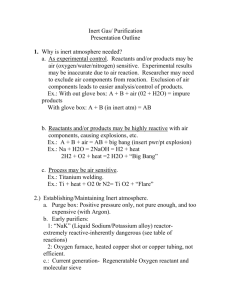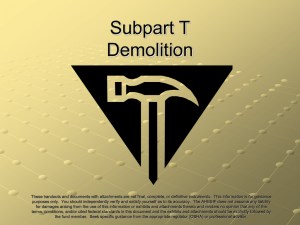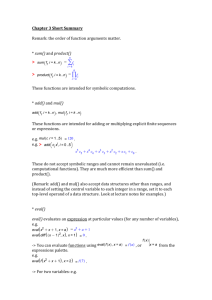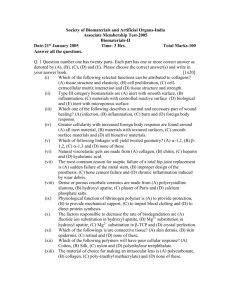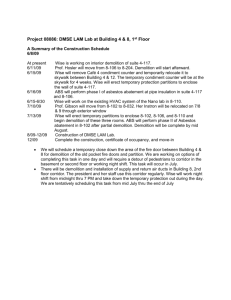The compositions of demolition wastes from Chi
advertisement
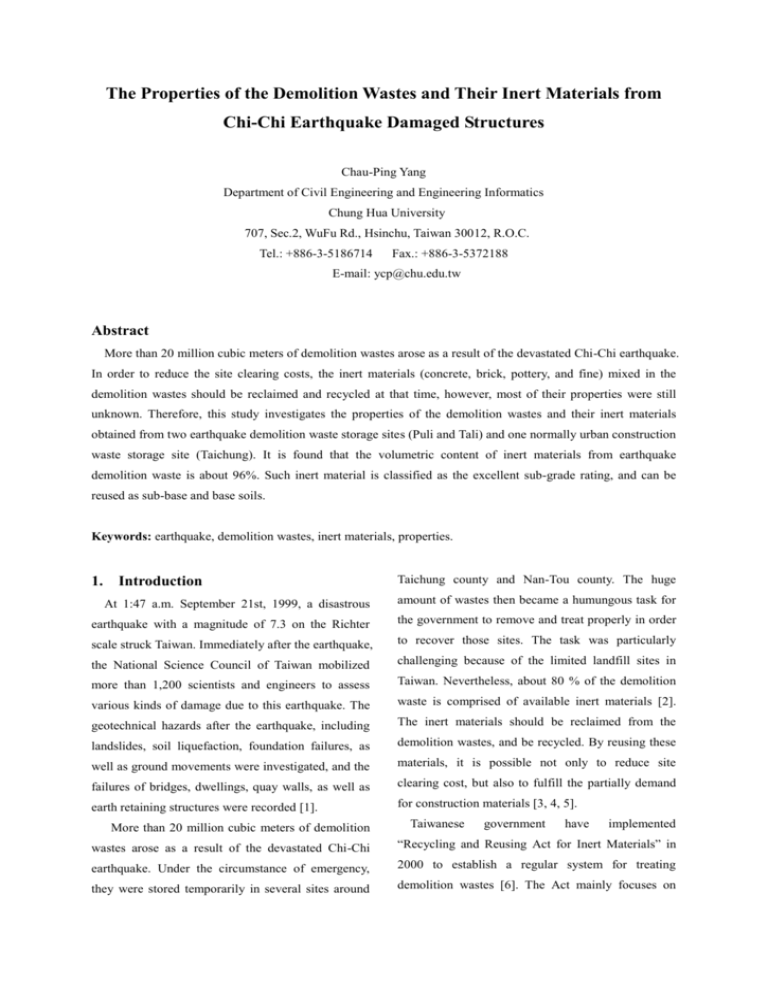
The Properties of the Demolition Wastes and Their Inert Materials from Chi-Chi Earthquake Damaged Structures Chau-Ping Yang Department of Civil Engineering and Engineering Informatics Chung Hua University 707, Sec.2, WuFu Rd., Hsinchu, Taiwan 30012, R.O.C. Tel.: +886-3-5186714 Fax.: +886-3-5372188 E-mail: ycp@chu.edu.tw Abstract More than 20 million cubic meters of demolition wastes arose as a result of the devastated Chi-Chi earthquake. In order to reduce the site clearing costs, the inert materials (concrete, brick, pottery, and fine) mixed in the demolition wastes should be reclaimed and recycled at that time, however, most of their properties were still unknown. Therefore, this study investigates the properties of the demolition wastes and their inert materials obtained from two earthquake demolition waste storage sites (Puli and Tali) and one normally urban construction waste storage site (Taichung). It is found that the volumetric content of inert materials from earthquake demolition waste is about 96%. Such inert material is classified as the excellent sub-grade rating, and can be reused as sub-base and base soils. Keywords: earthquake, demolition wastes, inert materials, properties. 1. Introduction Taichung county and Nan-Tou county. The huge At 1:47 a.m. September 21st, 1999, a disastrous amount of wastes then became a humungous task for earthquake with a magnitude of 7.3 on the Richter the government to remove and treat properly in order scale struck Taiwan. Immediately after the earthquake, to recover those sites. The task was particularly the National Science Council of Taiwan mobilized challenging because of the limited landfill sites in more than 1,200 scientists and engineers to assess Taiwan. Nevertheless, about 80 % of the demolition various kinds of damage due to this earthquake. The waste is comprised of available inert materials [2]. geotechnical hazards after the earthquake, including The inert materials should be reclaimed from the landslides, soil liquefaction, foundation failures, as demolition wastes, and be recycled. By reusing these well as ground movements were investigated, and the materials, it is possible not only to reduce site failures of bridges, dwellings, quay walls, as well as clearing cost, but also to fulfill the partially demand earth retaining structures were recorded [1]. for construction materials [3, 4, 5]. More than 20 million cubic meters of demolition Taiwanese government have implemented wastes arose as a result of the devastated Chi-Chi “Recycling and Reusing Act for Inert Materials” in earthquake. Under the circumstance of emergency, 2000 to establish a regular system for treating they were stored temporarily in several sites around demolition wastes [6]. The Act mainly focuses on administration management, yet technological As for the demolition waste of the Tali site, the specifications for design and construction are hardly content of inert material and impurity are 96.45% and covered by this act. In practice, the specifications 3.55%, respectively. Although its composition is involved in that act should be defined more close to that of the Puli site, the content of concrete concretely for inert materials. However, most of the (51.02%) is higher than that of the Puli site (33.66%). properties of inert materials from different areas were The major sources were reinforced brick and concrete still unknown. Thereby, the properties of the building since the Tali city is a rather developed demolition wastes and their inert materials ( particle urban area. diameter < 76.2 mm ) obtained from three storage On the other hand, the content of inert material and sites were studied in this paper. The three sites are impurity of the demolition waste from the Taichung Puli, Tali and Taichung. The test materials of the Puli site are 78.61% and 21.39%, respectively. It is site and Tali site were demolition wastes from obvious that the impurity in the waste of the Taichung Chi-Chi earthquake damaged structures, while that of site is higher than those of the other sites, as the the Taichung site was obtained from a regular sources of the waste of the Taichung site were not recycling factory, which was a normally urban only from demolition buildings but also from construction waste, and was tested for comparison demolition interiors and dug earth works. purpose. Unit weights 2. Properties of demolition wastes Compositions For investigating the unit weights of the above mentioned materials, a shovel-type excavator was For investigating the compositions of demolition driven onto each hill to dig a shovel of the materials wastes, a shovel-type excavator was driven onto each at three points. Then the mixture of the three shovels waste hill (see Figure 1). Where a shovel of wastes of dug materials was loaded on a truck whose 3 (about 1.5 m ) were dug-up at three points with a distance of about 50 m between two points. The wastes in these three shovels were mixed and then about 3,000 N of the mixture were sampled as the test materials. First, the test materials were classified into inert materials and impurities. The composite materials sub-classified from impurities were metal, glass, wood, paper, plastic, rubber, etc. The contents measured by volume in the demolition wastes from the three sites are listed in Table 1. It is found that the content of inert material is 96.48% and that of impurity is 3.52% for the demolition waste from the Puli site. Most of the demolition waste was inert material because it was container had a known volume. Moreover, the weight of the mixture was measured so that the unit weight can be obtained. The procedure was repeated for three times to attain three sampled values of the unit weight. Accordingly, the unit weight measured in this way was under wet and loose condition. So that it is a bulk unit weight. The unit weights of demolition wastes, inert materials, and impurities from the three sites are listed in Table 2. Instead of standard deviation, the statistic parameter of range of variation ( = the maximum value – the minimum value) is used to express the degree of variation of data because only three values were measured for each item. The mean unit weights of demolition wastes from the Puli site, gathered from a mountainous area, and the major sources were earth block building, reinforced brick building, as well as light-steel houses. Tali site, and Taichung site are 11.8 kN / m 0.5), 14.0 kN / m 3 3 ( = ( = 0.4), and 9.1 kN / m 3 ( = 0.4), respectively. It is found that the unit of inert materials from the three sites were tested, and weight of the demolition waste from the Taichung their particle-size distribution curves were obtained. site is rather smaller compared with that of the other Recycled inert material should be crushed and sites because the former site contained greater screened to produce useful construction soils that impurities. satisfy various specifications of earth structure reuses. On the other hand, the mean unit weights of the Thus, the gradation of inert material becomes a basic impurities from the Puli site, Tali site, and Taichung characteristic for laying out reclaimed machines and site are 3.3 kN / m ( = 0.2), 2.8 kN / m 3 0.1), and 3.0 kN / m 3 3 ( = ( = 0.3), respectively. As sieves. On the other hand, if the inert material is directly reused as land backfill, embankment and pavement without adjusting its gradation, then its for the inert materials, the mean unit weights for the properties of compaction and level of California Puli Bearing-Ratio (CBR) should be known. site, Tali 13.5 kN / m 3 site, and Taichung ( = 0.5), 14.8 kN / m and 13.8 kN / m 3 ( 3 site are ( = 0.3), = 0.4) , respectively. The Gradations The gradations of inert materials from the three values of unit weights of the impurities and inert sites were tested according to ASTM D-136. Their materials of the three sites are relatively close. particle-size distribution curves are shown in Figure 2, On the date of investigation, the moisture and their engineering properties are listed in Table 3. contents of demolition wastes from the Puli site, Tali All of the inert materials are classified as “GP” site, and Taichung site were 12.5%, 13.6%, and (poorly 13.8%, respectively. It should be noted that the values Classification System and as “A-1-a” by the of unit weights of those materials may varied with AASHTO Classification System. Note that according weather conditions. The main cost of the reclamation to the AASHTO Classification System, all the inert project includes classification of demolition waste, materials are judged as the most excellent sub-grade treatment of inert material, and combustion of rating. On the other hand, the percents of blocks impurity. The cost is evaluated by weight, e.g., the (diameter > 76.2 mm ) for the Puli site, Tali site ,and product of volume and unit weight. As a result, the Taichung site are 24, 37, and 21, respectively (see measurements of those unit weights are important for Figure 2). They should be crushed to produce useful the reclamation project. As Taiwan is abundant in rain, construction it is suggested that the average unit weight should be specifications. For example, the specified maximum evaluated by two experiments, one on a day after size of construction soil for land backfill, sub-grade raining day and one on a dry sunning day. and embankment is 150 mm [7, 8, 9]. 3. Compactions Properties of inert materials The properties of inert materials were Three graded gravel) soils inert that materials by the satisfy were Unified various Soil reuse compacted in investigated in laboratory. However, due to the accordance with the specification of modified Proctor particle size limitation regulated by the related test test (ASTM-D1557 Method D, compaction energy = specifications for aggregate and soil, only the inert 2696 kJ / m ) materials passing through 76.2 mm sieve were adopted as test materials. First of all, the gradations 3 in order to obtain their moisture content-dry unit weight relationships (compaction curves). The dry unit weight of a specimen d should be corrected by the content of over-size part, 12 h prior to the test. Upon test, it was compacted because this method specifies the maximum size of with efforts of 312 kJ / m , 937 kJ / m , and testing material as 38.1 mm . Figure 3 shows the 3 2030 kJ / m 3 3 , respectively, to produce three compaction curves of the three inert materials. The compaction curves in moisture content-dry unit specimens with different values of d , which were weight plane for the Puli site and Tali site are close. then soaked. Subsequently, each soaked specimen However, the compaction curve of the Taichung site were placed in the compression machine and is lower than those of the other two sites because penetration reading were taken together with the more light impurities and natural soils were contained corresponding load reading. The CBR number (or, in the inert material. simply, the CBR) was obtained as the ratio of the from stress required to penetrate a certain depth into a compaction curves (see Figure 3) are listed in Table 3. soaked specimen over the standard stress, which It is known that the optimum moisture contents wopt corresponds to the same penetration depth on a Those compaction results obtained standard sample of crushed stone. The same test for the Puli site, Tali site, and Taichung site are 11.0%, 11.9%, and 15.7%, respectively. The values of the maximum dry unit weights sites are 19.4 kN / m 3 d (max) for these three , 18.7 kN / m 3 procedure was done for the other two soaked specimens. Thus, three sets of test data of ( d , CBR) were obtained and they were plotted in the , and d -CBR plane, as shown in Figure 4, to calculated a linear 3 17.1 kN / m , respectively. The state at which the regression equation. By using the equation, the CBR optimum moisture content and maximum dry unit numbers for two different compaction states of inert weight is attained is generally referred to as the “optimum compaction state”. Referring to the “Specification of Public Construction – Earth Works” enacted by the Public Project Mission of Taiwan, the inert material can be used as construction soil only if its value of d (max) 3 is larger than 14.7 kN / m . Thus, the properties of compaction of the three inert materials are above the required level. materials, d 0.95 d (max) and d = d (max) , can be calculated. For inert materials with dry unit weight of ( 0.95 d (max) ), the CBR numbers for the Puli site, Tali site, and Taichung site are 62%, 59%, and 54%, respectively (see Table 3). Moreover, for inert materials with dry unit weights of d (max) , the CBR numbers for these three sites are 113%, 129%, and Levels of CBR 103%, respectively. It is known that the compacted Currently, the CBR test has been developed as states largely affect their CBR numbers. According to means of classifying the suitability of a soil for use as “Manual of Highway Construction” enacted by the a pavement course material in highway construction. Taiwan Highway Bureau (1997), the required CBR The CBR tests for the three inert materials were numbers of sub-grade, sub-base, and base soil are performed in accordance with the specification of 85%, 35%, and 15%, respectively. Therefore, under ASTM-D1883. Accordingly, the inert material was the case of ( 0.95 d (max) ), the inert materials from mixed with the necessary amount of water to obtain the requisite percentage of the optimum moisture content and was stored in a sealed container for about the three sites can be reused as sub-base and base soil. 4. Taiwan, Conclusions earthquake: special lecture.” In Proceedings of the 4th International Conference The main conclusions from this study are summarized as follows: on Recent Advances in geotechnical Earthquake (1) The volumetric content of inert material from Engineering and Soil Dynamics, San Diego, earthquake demolition waste is about 96%, California., mass. pp. 26-31, Mar. 2001, Paper which is significantly higher than that of 79% SPL-10.1, University of Missouri-Rolla, Rolla, from normally urban construction waste. Mo. (2) The mean unit weights of demolition wastes from the Puli site, Tali site, and Taichung site are 3 3 3 11.8 kN / m , 14.0 kN / m , and 9.1 kN / m , [2]. Environmental Protection Administration, Taiwan. (2000). Utilization of demolition waste from Chi-Chi earthquake damaged structures. Ch.3. respectively. (3) Three inert materials are classified by AASHTO system as “A-1-a”, However their blocks should be crushed to produce useful construction soils [3]. Sorvari, J., (2003). “By-products in earth construction: environmental assessments.” Journal of Environmental Engineering, Vol. 129, No.10, pp. 899-909. that satisfy various reuse specifications. (4) According to the properties of compaction of the three inert materials, they can be re-used as [4].Khalaf, F. M., and DeVenny, A. S., (2004). “Recycling of demolished masonry rubble as coarse aggregate in concrete: review.” Journal of construction soils. (5) Under the case of ( 0.95 d (max) ), the inert materials from the three sites can be reused as sub-base and base soil. Materials in Civil Engineering, Vol. 16, No. 4, pp. 331-340. [5]. Poon, C. S. and Chan, D., (2005). “Paving blocks made with recycled concrete aggregate and crushed clay brick.” Construction and Building Acknowledgements Materials, Vol. 20, No. 8, pp. 569-577. This study is carried out under the financial [6]. Construction & Planning Agency, Ministry of support of the National Science Council, Taiwan Interior, Taiwan. (2000). Recycling and Reusing (NSC93-2211-E-216-003). Thanks are also given Act for inert Materials. to Public Construction Commission, Recovery Committee of 921 Chi-Chi earthquake, [7]. Sekine, E., and Ikeda, T., (2003). “Geotechnical characteristics of crushed concrete for Environmental Protection Administration, Water mechanical stabilization.” Tsuchi To Kiso, Vol. Resources 51, No. 5, pp. 31-33, Japan. Agency, Taiwan Area National Expressway Engineering Bureau, related local [8]. Shimoda, Y., (2003). “Plans to use construction authorities and Jo-Mao Reclamation Company, by-products as construction materials in Tokyo Taiwan. The author also wishes to express his Metropolitan.” Tsuchi To Kiso, Vol. 51, No. 5, pp. gratitude to Mr. Jian-Hau Nae who helped field 22-24, Japan. investigations presented in this paper. [9]. Taiwan Highway Bureau. (1997). Manual of Highway Construction. pp.15-21. References [1]. Ueng, T. S., Lin, M. L., and Chen, M. H., (2001). “Some geotechnical aspects of 1999 Chi-Chi, Table 1. Contents of demolition wastes from the three sites Composite materials Content by volume (%) Puli site Tali site Taichung site Inert Concrete 33.66 material Brick 25.59 Fine 37.23 24.84 46.37 Metal 0.06 0.02 0.002 Glass 0.12 0.07 0.007 Wood 2.54 Paper 0.12 0.56 1.43 Rubber and plastic 0.68 0.50 1.73 Impurity 51.02 96.48 20.75 96.45 21.49 3.52 11.49 3.55 2.40 78.61 21.39 18.22 Table 2. Unit weights of demolition wastes, impurities and inert materials 3 Unit weight ( kN / m ) Demolition waste Impurity Site Measured value Mean Range of variation 11.6 Puli 11.7 Taichung 13.8 11.8 0.5 3.3 Measured value 14.0 0.4 2.8 2.8 9.3 2.9 9.1 0.4 3.2 Range of Mean variatio n 13.5 3.3 0.2 3.1 2.9 13.8 9.1 Range of Mean variatio n 3.5 12.1 14.2 Tali Measured value Inert material 13.3 13.5 0.5 14.8 0.3 13.8 0.4 13.8 15.0 2.8 0.1 14.7 14.7 0.3 3.0 8.9 3.0 Note:(1) The values of unit weights may varied with weather conditions; (2) The moisture contents of demolition wastes from Puli site, Tali site and Taichung site were 12.5%, 13.6% and 13.8%, respectively. 14.0 13.9 13.6 Table 3. Properties of inert materials from the three sites Properties Unified Soil Classification System AASHTO Classification System Puli Optimum moisture content wopt (%) Maximum dry unit weight d (max) 3 ( kN / m ) CBR (%) for specimens with d 0.95 d (max) Level of CBR (%) for specimens with d d (max) Level of GP A-1-a 11.0 Tali GP A-1-a 11.9 Taichung GP A-1-a 15.7 19.4 18.7 17.1 62 59 54 113 129 103 Figure 1. Demolition waste in Puli site 100 90 Inert materials Mixed Mixture ((■■:Puli) :Puli) Percent finer finer (%) Percent (%) 80 70 60 50 ((▲▲:Taichung) :Taichung) 40 30 20 ●:Tali) (●(:Tali) 10 0 100 10 1 0.1 0.01 0.001 Particle (mm) Particlediameter diameter (mm) Figure 2. Particle-size distribution curves of inert materials from the three sites 21 33 3 )) Dry unit Dry weight (kN/m Dryunit ) unitweight weight (kN/m (kN/m Inert materials Mixture Mixed 20 20 :Puli) ((■■:Puli) 19 (●:Tali) (● :Tali) 18 (▲ ▲:Taichung) :Taichung) 17 16 7 9 11 13 15 17 19 21 Moisturecontent content (%) (%) Moisture Figure 3. Compaction test results of inert materials from the three sites 20.0 20.0 Mixed Mixture Inert materials 3 3) Dry weight (kN/m 3 ) Dry unit unit weight 3 Dry weight (kN/m (kN/m Dryunit ) ) density (kN/m 19.5 19.5 Puli(█ ):):y=0.018x Puli( +17.386 y = 0.0179x+17.39 ■ 19.0 19.0 18.5 18.5 18.0 18.0 Tali( ●):y=0.013x ●): Tali( +17.041 y = 0.0129x+17.04 17.5 17.5 17.0 17.0 16.5 16.5 Taichung( ): ):y=0.018x ▲▲ Taichung( +15.267 y = 0.0178x+15.27 16.0 16.0 15.5 15.5 20 20 40 40 60 60 80 80 100 100 120 120 140 140 160 160 180 180 CBR(%) CBR (%) Figure 4. The relationships between CBR and dry unit weight of inert materials from the three sites
